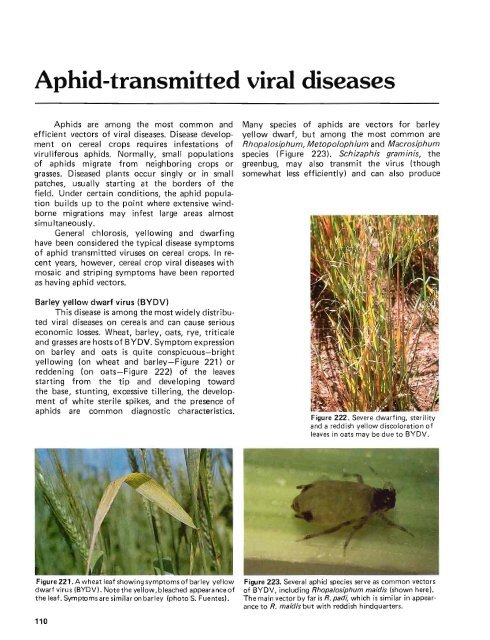Distinguishing the species - CIMMYT
Distinguishing the species - CIMMYT
Distinguishing the species - CIMMYT
You also want an ePaper? Increase the reach of your titles
YUMPU automatically turns print PDFs into web optimized ePapers that Google loves.
Aphid-transntitted viral diseases<br />
Aphids are among <strong>the</strong> most common and<br />
efficient vectors of viral diseases. Disease development<br />
on cereal crops requires infestations of<br />
viruliferous aphids. Normally, small populations<br />
of aphids migrate from neighboring crops or<br />
grasses. Diseased plants occur singly or in small<br />
patches, usually starting at <strong>the</strong> borders of <strong>the</strong><br />
field. Under certain conditions, <strong>the</strong> aphid population<br />
builds up to <strong>the</strong> point where extensive windborne<br />
migrations may infest large areas almost<br />
simu Itaneously.<br />
General chlorosis, yellowing and dwarfing<br />
have been considered <strong>the</strong> typical disease symptoms<br />
of aphid transmitted viruses on cereal crops. I n recent<br />
years, however, cereal crop viral diseases with<br />
mosaic and striping symptoms have been reported<br />
as having aphid vectors.<br />
Barley yellow dwarf virus (BYDV)<br />
This disease is among <strong>the</strong> most widely distributed<br />
viral diseases on cereals and can cause serious<br />
economic losses. Wheat, barley, oats, rye, triticale<br />
and grasses are hosts of BYDV. Symptom expression<br />
on barley and oats is quite conspicuous-bright<br />
yellowing (on wheat and barley-Figure 221) or<br />
reddening (on oats-Figure 222) of <strong>the</strong> leaves<br />
starting from <strong>the</strong> tip and developing toward<br />
<strong>the</strong> base, stunting, excessive tillering, <strong>the</strong> development<br />
of white sterile spikes, and <strong>the</strong> presence of<br />
aph ids are common diagnostic characteristics.<br />
Many <strong>species</strong> of aphids are vectors for barley<br />
yellow dwarf, but among <strong>the</strong> most common are<br />
Rhopa/osiphum, Metop%phium and Macrosiphum<br />
<strong>species</strong> (Figure 223). Schizaphis graminis, <strong>the</strong><br />
greenbug, may also transmit <strong>the</strong> virus (though<br />
somewhat less efficiently) and can also produce<br />
Figure 222. Severe dwarfing, sterility<br />
and a reddish yellow discoloration of<br />
leaves in oats may be due to BYDV.<br />
Figure 221. A wheat leaf showing symptoms of barley yellow Figure 223. Several aphid <strong>species</strong> serve as common vectors<br />
dwarf virus (BYDV). Note<strong>the</strong>yellow,bleached appearanceof of BYDV, including Rhopa/osiphum maidis (shown here).<br />
<strong>the</strong> leaf. Symptoms are similar on barley (photo S. Fuentes). The main vector by far is R. padi, wh ich is similar in appear·<br />
ance to R. maidis but with reddish hindquarters.<br />
110

















